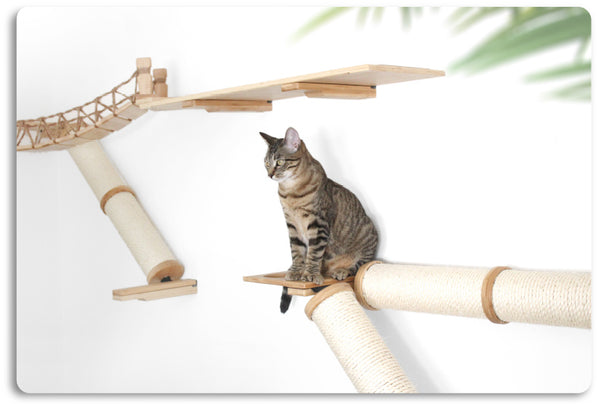Cats are excellent at hiding their pain. Many times, by the time you know your cat is sick, disease may be advanced. Cats pretty much live by the rule “eat or be eaten”, so they instinctively hide their pain as a survival mechanism to prevent other predators from viewing them as weak or vulnerable. While there may be no predators stalking your cat in your home, natural instincts still win the battle.
Signs Your Cat May Be in Pain
- Clumpy, dry coat from decreased grooming
- Sleeping more, decreased activity
- Hiding, less interaction with the family
- Loss of appetite with weight loss
- Aggression toward family members or other pets in the home
- Flinching when touched
- Accidents outside the litterbox
- Increased vocalization
- Dilated pupils

Osteoarthritis Pain
Many veterinarians have noted that radiographs of cats show signs of osteoarthritis as early as age five, but most cats do not show symptoms of arthritis pain until much later in life. Clinical signs of osteoarthritis may include weight loss, loss of appetite, depression, change in general attitude, poor grooming habits, urination or defecation outside the litter box, and inability to jump on and off objects. Lameness is not commonly reported. Astute owners may notice their cat is not jumping up or down on furniture as often or the jumps may be shorter.
Other Causes of Pain

- Dehydration
- Infection
- Kidney and urinary tract disease
- Cancer or tumors
- Wounds
- Trauma
Researchers Developed a Pain Scale
Researchers at the University of Montreal developed the Feline Grimace Scale, which has gained wide acceptance and use among veterinarians to determine the pain level a cat may be experiencing. Assessment and management of pain is essential in ensuring the best quality of life for all animals, yet the recognition and evaluation of pain remains a major limiting factor in pain management for pets. There is good evidence that facial expression can be a useful, valid, and reliable tool for recognizing and evaluating pain in humans and other animals. Both the sensory and emotional components of pain have been demonstrated to affect facial expression. Many of the mammalian species studied to date have similar facial expression responses to pain. The researchers evaluated hundreds of cats; they categorized, tested, and scored five facial action units indicative of pain in cats:
- Ear position: Ears facing forward, ears slightly pulled apart, or ears flattened and rotated outward
- Orbital tightening: Eyes opened, eyes partially opened, or eyes squinted
- Muzzle tension: Muzzle relaxed (round), muzzle mildly tense, or muzzle tense (elliptical)
- Whisker position: Whiskers relaxed and curved, whiskers slightly curved or straight, or whiskers straight and moving forward
- Head position: Head above the shoulder line, head aligned with the shoulder line, or head below the shoulder line or tilted

The cat with no pain has ears standing up, eyes round and wide open, a rounded muzzle, relaxed whiskers, and head above the shoulders. The cat on the left shows all those features. A cat experiencing moderate pain will have eyes squinted, ears more to the side, less downward curvature in the whiskers, a less-rounded muzzle, and head at the shoulder level. The center cat is demonstrating a painful expression, but he is still interactive with his observers. Cats with more severe pain will have eyes squinted or shut, ears flat to the sides, straight or upwardly curved whiskers, more tension in the muzzle, and head below the shoulders. The cat on the right is showing a significant amount of pain; he has no interest in interacting with his observers.
A Trip to the Veterinarian is Up Next
Once it is determined that a cat is experiencing pain, the next step is to determine the cause. If you suspect your cat is showing signs of pain, a trip to your veterinarian for a full examination, bloodwork, and radiographs should be arranged. The examination should include flexion, extension, and palpation of all joints, including the spine, palpation of the major muscle groups for tension or spasms, and an oral examination to determine if there is severe dental disease or oral cancer. Abdominal palpation can reveal enlarged organs, masses, or bladder obstruction. Auscultation of the chest with a stethoscope can potentially reveal heart or lung disease.

Blood and urine samples should be collected to determine whether there is any organ failure that might be causing swelling or dehydration. Kidney disease can result in severe dehydration. Some of the most painful cats I dealt with in veterinary practice were cats with kidney disease experiencing profound dehydration. Those cats would become very withdrawn, try to curl into a small ball and hide, or acted out when handled. Rehydration with fluids (when possible) resulted in a totally different demeanor. Radiographs (X-rays) can reveal bladder or kidney stones, enlarged or shriveled organs (kidneys, liver, spleen), bowel obstructions, and masses that could be cancerous. If radiographs are inconclusive, the next step would be an abdominal ultrasound to look for thickened bowel walls that might be indicative of inflammation or cancer, as well as the structure of the liver, kidneys, and other organs. Chest X-rays can show heart enlargement, asthma, and cancers in the lungs.

Treating Pain in Cats
There are very few pain medications available for use in our feline patients. Over-the-counter human medications should never be given to cats. Ibuprofen, acetaminophen, naproxen, and aspirin can all be deadly to cats, even with a single dose. They can cause internal bleeding, bowel ulceration, liver failure, and kidney failure. Your veterinarian may prescribe an NSAID (non-steroidal anti-inflammatory drug) such as Onsior (robenacoxib) or Metacam (meloxicam), but these cannot be used long term. Other options your veterinarian may consider include:
- Opioids including codeine, fentanyl, hydromorphone, morphine, and tramadol which can be used for severe pain. Generally, these are reserved for use before and after surgery or for advanced disease such as cancer.
- Corticosteroids reduce inflammation. They include dexamethasone, prednisone, and prednisolone. These should not be used long terms, as they can cause high blood pressure and diabetes.
- Gabapentin is a seizure medication that helps treat pain in nerves, muscles, and bones. It also has a sedative effect in cats.
- Amitriptyline is a human antidepressant medication that can help with nerve pain in cats. It is rarely used.
- Buprenorphine is a synthetic opiate that can be given by injection or by mouth that is safe for longer use. However, it should not be used in cats with kidney disease, liver disease, head trauma, compromised cardiovascular function and geriatric or severely debilitate animals.
Prevention is the Key
Rather than using drugs that may have severe side effects, there are more natural options to help support cats with pain. Feeding a high-moisture, species-appropriate diet will help keep your cat naturally well hydrated, decrease chances of obesity, and help deter urinary tract disease. Regular veterinary visits with routine laboratory testing will alert you to impending disease. Joint supplements can help ward off osteoarthritis. Natural, herbal, and homeopathic pain management products are available. Regular exercise and interaction with family members can help keep your cat healthy.























